Since the official release of the iPhone 13 series, there have been speculations regarding the iPhone 14 series. One of the most popular rumors is that the iPhone 14 series will use a punch-hole display for the first time. Other reports claim that only the iPhone 14 Pro models will use a punch-hole display. For a long time (since 2017), many generations of iPhones use the notch design. This year, Apple will make a significant change to the display of its smartphones.
In addition to previous reports, a new report from @DylanDKT claims that the iPhone 14 Pro will use a new design. @DylanDKT claims that the iPhone 14 Pro will use a punch-hole display. Furthermore, he said that the FaceID sensor will be under the display. This implies that the iPhone 14 Pro will probably use a pill-shape punch-hole. The front camera will probably be on one side of the pill while the FaceID will be on the other side.
iPhone 14 series will have four models
According to previous revelations, the iPhone 14 may still use the notch design. This will distinguish it from the Pro series. As for the mini model, Apple will discontinue the mini model with the iPhone 13 mini. However, the company will still have four new iPhones later this year. It will have the iPhone 14, iPhone 14 Max, iPhone 14 Pro, and iPhone 14 Pro Max. These four models will have two display sizes including 6.1-inch and 6.7-inch versions.
The appearance of past generations of iPhone has attracted much attention. However, from the iPhone 11 series to the iPhone 13 series, the appearance of the iPhone has not changed much. This is mainly because they all come with a notch design. Of course, the changes in the iPhone 12 series are quite big, after all, the frame has changed from rounded corners to a right-angled design.
In addition, there are reports that the iPhone 14 series will continue to use the A15 Bionic chip. However, the iPhone 14 Pro series will use the A16 Bionic chip (tentatively named) with a 4nm process technology. As of now, we can not ascertain the authenticity of the chip information for some reason. We know that there is already an A16 Bionic SoC, thus Apple has no reason to impose this restriction. Furthermore, it is not Apple’s pattern to use different chips for the same series. Whether or not the company will use two chips for the iPhone series remains to be seen.
